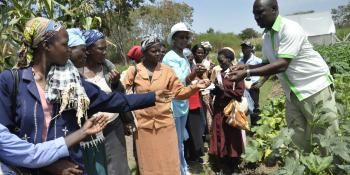Chicken to the rescue: How farmers in Nyando are managing climate risks

How do village chicken improve farmers' food security?
Long experiences of uncertainty about weather patterns has spurred smallholder farmers into looking for ways to address climate change related risks. As the rainy seasons are characterized by late onset, early cessation, uneven geographical distribution, and prolonged and frequent dry spells, keeping higher flocks of village chicken by women farmers is becoming more common in the rural areas.
In the Nyando Climate-Smart Villages (CSVs), most agricultural activities are undertaken by women farmers. The existing community based organizations (CBOs) that are made up of several farmer groups are expanding collective action for agricultural innovations through loaning from Community Innovation Funds. The farmers borrow funds for investing in village chicken farming, which has been prioritized and embraced by women. The CBOs manage the credit system at village level by accepting payment-in-kind as a means of loan repayment.
Indigenous village chicken under free range system
All the households keep a number of indigenous village chickens under traditional free range semi-scavenging systems. The average number of birds are 30 per household. The chickens are generally owned by women and children to generate cash revenue and supply eggs and meat to their personal family’s diet. In addition, village chickens help to provides high quality fertilizer, and act as a form of household savings and insurance.
Indigenous village chickens are preferred because they can thrive despite irregular supply of feed and water and with minimum healthcare. One of the most important positive characters of these village chicken is their hardiness, which is ability to tolerate the harsh environmental condition and unimproved husbandry practices (handling, watering, and feeding) without much loss in production. These chicken are part of balanced crop-livestock farming systems. They have vital roles in the Nyando households as a source of high quality animal protein and emergency cash and play a significant role in the sociocultural life of the community. Although indigenous village chickens are slow growers and layers of small sized eggs, the hens are ideal mothers and good sitters, excellent foragers, and possess natural immunity against common diseases. Chicken generally scavenge around the homestead during day time, where they eat kitchen waste, left over cereal like sorghum, legumes, green grass, insects, and other available feed stuff.
Crossbred chicken under improved management
About 40% of Nyando farmers also keep improved chicken breeds, in addition to the indigenous flock. The popular cross breeds are “Kuroiler”, ”Kenbrew” and “Rainbow” breeds. Farmers get improved chicks from commercial hatcheries, and raise them in improved chicken housing designed to accommodate at least 50 birds. The reasons that make women farmers go for the improved breeds is because they mature faster, have tender meat, and also produce more eggs compared to the indigenous ones.
The potential for egg production and growth is very low under smallholder farmer’s scavenging systems. Whereas the indigenous breeds take 12 months from hatching to attain 2 kg live weight, the improved breeds take 4 months to attain that weight and can be sold for meat. In case the farmers want the improved chicken to lay eggs, they retain the hens for a longer time. These hens start laying eggs from the age of six months for a period of one year before the egg production ability reduces; when they are sold off. Within the egg-laying period of 12 months, the improved hens give an average of 320 eggs which translates to 26 eggs per month, that is about three times higher than eggs produced by indigenous chicken in the same period.
In order to improve levels of production, the farmers undergo training on the following:
- Construction and maintenance of improved chicken housing
- Elaborate feeding program that involves formulation of feed from locally available foods
- Disease control and treatment
- Record keeping
Farmer Risper Ogogo of Onyuongo village of Kisumu County is an elderly widow with six children and owns 0.6 hectares of land. She has dedicated her time and energy into chicken production. She sells eggs and chicken for meat, enabling her to purchase other kinds of food for her family.
“I have invested my energy and resources into improved chicken farming for five years now. Before 2012, I could only manage to have a flock of 15 indigenous chicken that was mainly meant for slaughter for my visitors – a habit that most of our people adhere to. Currently, I rear improved birds and my flock size varies from time to time ranging between 75 and 150 birds. I ensure proper chick management, good feeding regime, and disease control and management through routine vaccinations and improved hygiene. Each year, I earn Kenya Shillings 120,000 (USD 1,200) from poultry only,” Risper asserts.
Risper strives to maintain and improve her chicken production by seeking for more knowledge from all sources within her reach. She participates in farmer training workshops, seeks for advice from livestock extension agents working in the community, and even her fellow champion farmers with the same enterprise. To scale up this innovation, knowledge is shared through farmer learning events, farmer exchange visits, and training through agricultural fairs and exhibitions.
John Recha and Philip Kimeli work for CCAFS East Africa.



